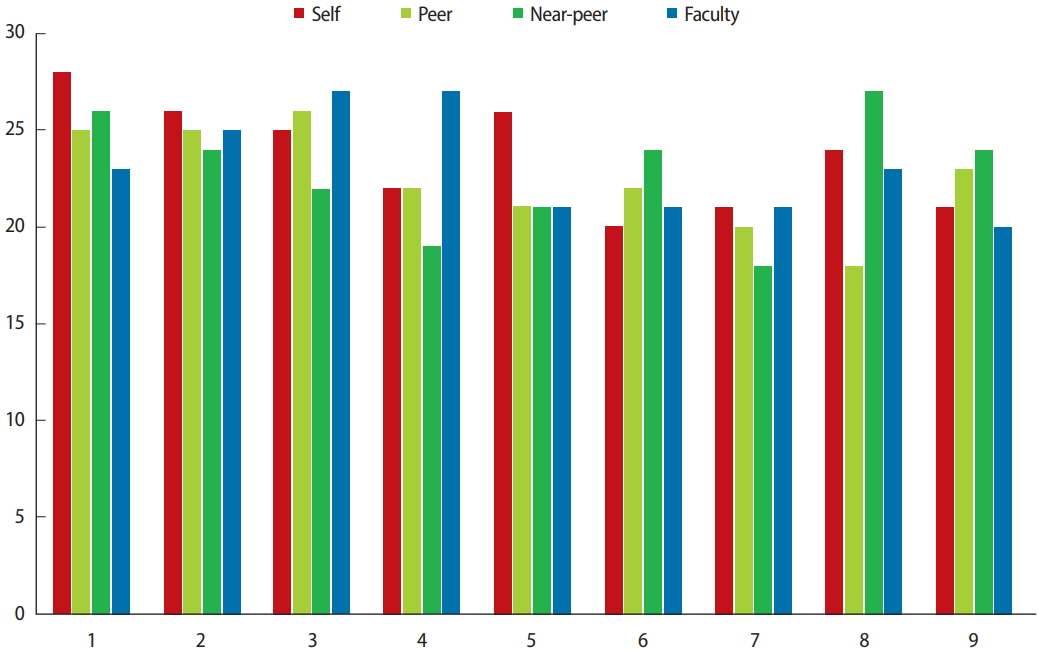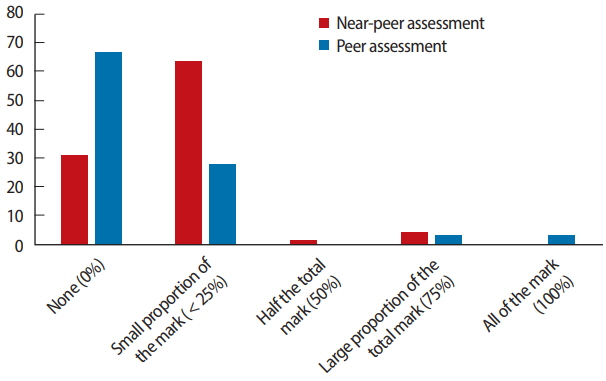J Educ Eval Health Prof.
2018;15:22. 10.3352/jeehp.2018.15.22.
Learning through multiple lenses: analysis of self, peer, near-peer, and faculty assessments of a clinical history-taking task in Australia
- Affiliations
-
- 1College of Health and Biomedicine, Victoria University, Melbourne, Australia. kylie.fitzgerald@vu.edu.au
- 2Department of Medical Education, Melbourne Medical School, University of Melbourne, Melbourne, Australia.
- KMID: 2439278
- DOI: http://doi.org/10.3352/jeehp.2018.15.22
Abstract
- PURPOSE
Peer assessment provides a framework for developing expected skills and receiving feedback appropriate to the learner's level. Near-peer (NP) assessment may elevate expectations and motivate learning. Feedback from peers and NPs may be a sustainable way to enhance student assessment feedback. This study analysed relationships among self, peer, NP, and faculty marking of an assessment and students' attitudes towards marking by those various groups.
METHODS
A cross-sectional study design was used. Year 2 osteopathy students (n=86) were invited to perform self and peer assessments of a clinical history-taking and communication skills assessment. NPs and faculty also marked the assessment. Year 2 students also completed a questionnaire on their attitudes to peer/NP marking. Descriptive statistics and the Spearman rho coefficient were used to evaluate relationships across marker groups.
RESULTS
Year 2 students (n=9), NPs (n=3), and faculty (n=5) were recruited. Correlations between self and peer (r=0.38) and self and faculty (r=0.43) marks were moderate. A weak correlation was observed between self and NP marks (r=0.25). Perceptions of peer and NP marking varied, with over half of the cohort suggesting that peer or NP assessments should not contribute to their grade.
CONCLUSION
Framing peer and NP assessment as another feedback source may offer a sustainable method for enhancing feedback without overloading faculty resources. Multiple sources of feedback may assist in developing assessment literacy and calibrating students' self-assessment capability. The small number of students recruited suggests some acceptability of peer and NP assessment; however, further work is required to increase its acceptability.
MeSH Terms
Figure
Reference
-
References
1. Tai JH, Canny BJ, Haines TP, Molloy EK. The role of peer-assisted learning in building evaluative judgement: opportunities in clinical medical education. Adv Health Sci Educ Theory Pract. 2016; 21:659–676. https://doi.org/10.1007/s10459-015-9659-0.
Article2. Deeley SJ, Bovill C. Staff student partnership in assessment: enhancing assessment literacy through democratic practices. Assess Eval High Educ. 2017; 42:463–477. https://doi.org/10.1080/02602938.2015.1126551.
Article3. Carless D, Boud D. The development of student feedback literacy: enabling uptake of feedback. Assess Eval High Educ. 2018; 43:1315–1325. https://doi.org/10.1080/02602938.2018.1463354.
Article4. Lanning SK, Brickhouse TH, Gunsolley JC, Ranson SL, Willett RM. Communication skills instruction: an analysis of self, peer-group, student instructors and faculty assessment. Patient Educ Couns. 2011; 83:145–151. https://doi.org/10.1016/j.pec.2010.06.024.
Article5. Van Zundert M, Sluijsmans D, van Merrienboer J. Effective peer assessment processes: research findings and future directions. Learn Instr. 2010; 20:270–279. https://doi.org/10.1016/j.learninstruc.2009.08.004.
Article6. Yu TC, Wilson NC, Singh PP, Lemanu DP, Hawken SJ, Hill AG. Medical students-as-teachers: a systematic review of peer-assisted teaching during medical school. Adv Med Educ Pract. 2011; 2:157–172. https://doi.org/10.2147/AMEP.S14383.
Article7. Vaughan B, Moore K, Kleinbaum A. Near-peer teaching in osteopathy clinical education. Int J Osteopath Med. 2017; 25:42–45. https://doi.org/10.1016/j.ijosm.2017.04.001.
Article8. Speyer R, Pilz W, Van Der Kruis J, Brunings JW. Reliability and validity of student peer assessment in medical education: a systematic review. Med Teach. 2011; 33:e572–e585. https://doi.org/10.3109/0142159X.2011.610835.
Article9. Kovach RA, Resch DS, Verhulst SJ. Peer assessment of professionalism: a five-year experience in medical clerkship. J Gen Intern Med. 2009; 24:742–746. https://doi.org/10.1007/s11606-009-0961-5.
Article10. Falchikov N, Goldfinch J. Student peer assessment in higher education: a meta-analysis comparing peer and teacher marks. Rev Educ Res. 2000; 70:287–322. https://doi.org/10.3102/00346543070003287.
Article11. Papinczak T, Young L, Groves M, Haynes M. An analysis of peer, self, and tutor assessment in problem-based learning tutorials. Med Teach. 2007; 29:e122–e132. https://doi.org/10.1080/01421590701294323.
Article12. Liu EZ, Lin SS, Yuan SM. Alternatives to instructor assessment: a case study of comparing self and peer assessment with instructor assessment under a networked innovative assessment procedures. Int J Instr Media. 2002; 29:395–404.13. Ahmed M, Arora S, Russ S, Darzi A, Vincent C, Sevdalis N. Operation debrief: a SHARP improvement in performance feedback in the operating room. Ann Surg. 2013; 258:958–963. https://doi.org/10.1097/SLA.0b013e31828c88fc.
Article14. Wen ML, Tsai CC. University students’ perceptions of and attitudes toward (online) peer assessment. High Educ. 2006; 51:27–44. https://doi.org/10.1007/s10734-004-6375-8.
Article15. Blanch-Hartigan D. Medical students’ self-assessment of performance: results from three meta-analyses. Patient Educ Couns. 2011; 84:3–9. https://doi.org/10.1016/j.pec.2010.06.037.
Article
- Full Text Links
- Actions
-
Cited
- CITED
-
- Close
- Share
- Similar articles
-
- Utilization and Effects of Peer‐Assisted Learning in Basic Medical Education
- The Effects of Peer Assessment and Peer Feedback in Writing Education for Premedical Students
- Reconsidering the Concept and Potential of Learning by Teaching
- Educational Implication of Peer Evaluation in Problem-based Learning
- An Analysis of the Relationship between Intragroup Peer Assessment Results and Self-Directed Learning Readiness in a Leadership Curriculum



